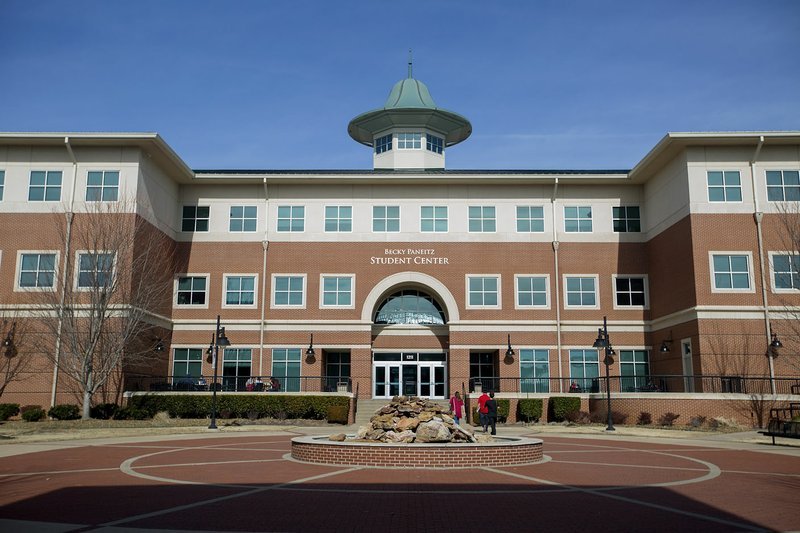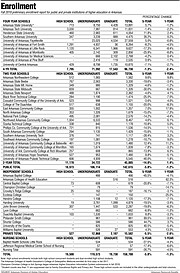Arkansas community colleges' enrollments are getting bigger for the first time in several years, thanks in large part to high school students taking courses while still working toward their high school diplomas.
Despite the community colleges' successes, enrollment at the state's public and private colleges and universities continues to contract, according to preliminary enrollment figures published this week by the Arkansas Division of Higher Education. The schools enrolled 158,788 students this fall, down from 2018 when 160,615 students were enrolled.
That's not expected to turn around anytime soon.
Nationally, experts expect a decline in the number of high school graduates and the number of students enrolled in colleges or universities.
"We call it the cliff-pocalypse," said Maria Markham, Higher Education Division director.
The enrollment cliff -- the point where postsecondary enrollments drop sharply after years of lower birthrates -- will pose a challenge across the nation. That's expected in 2025, Markham said.
To prepare, institutions are looking harder at retaining and graduating students, she said.
"One thing that we have stressed is that the college-going rate in Arkansas is pretty abysmal," she said.
The state's college-going rate is declining as the nation's is increasing. In the fall of 2017, 48.2% of the state's public and independent school students went to college, down from 51.4% in 2013. Nationally, that rate has risen from 65.9% in 2013 to 69.8% in 2017.
"We know that our graduating classes are getting smaller," Markham said. "We can't make more students materialize, but we can serve the students of Arkansas better."
The state's strategic plan for higher education calls for more residents to earn postsecondary credentials, which could range from certificates up to Ph.D.s. People with postsecondary credentials and higher degrees, on average, earn more money than those without, research has shown.
For the 2015-16 school year, retention was 81% across all four-year schools, for first-time, full-time undergraduates, according to the National Center for Education Statistics. It was 59% at open-admissions institutions and 95% at schools that accept less than 25% of applicants.
In Arkansas, retention for fall 2017 admissions was 68% across all institutions. It was 73.9% at four-year universities.
At their annual retreat in August, University of Arkansas System trustees heard a presentation about student retention from Michael Moore, the system's vice president for academic affairs.
That's how the system needs to prepare for the enrollment cliff, he told trustees. Most system schools -- all universities and most community colleges -- have retention initiatives underway, according to a document provided with the presentation.
For the University of Arkansas, Fayetteville, retention is not as high as it is at most other Southeastern Conference schools. Year-to-year retention fluctuates but was 83.8% last fall, up from 82.2% the previous fall.
UA has revamped its advising, added supplemental instruction for challenging courses, increased campus-housing aid and is building a student success center.
Its enrollment is down 0.8% this fall.
The University of Arkansas at Little Rock, which shows an 8.4% decline in students this fall, has started a retention committee, and is working on improving advising and bettering course design and support.
At Arkansas State University in Jonesboro, retention has improved from 68.3% for the fall of 2007 for full-time, first-time students to 76.5% in the fall of 2017.
There, the Chancellor's Commission on Completion has pursued strategies to improve advising, make registration easier, help students re-enroll and create new funds for students that would assist with small financial needs, according to a university retention announcement last year.
ASU's enrollment is down 1.2% this fall.
At the community college level, schools are targeting high school students, something most universities have not focused on as much.
From the fall of 2010 to the fall of 2018, the state's public community college enrollment plummeted 28.1%, from 61,980 in 2010 to 45,255 in 2018, according to final enrollment reports for both years.
It didn't fall further only because there was an increase in high school students -- from about 7,221 such students in the fall of 2010 to 10,307 in the fall of 2018, a preliminary report shows. That's a 42.7% increase. (The final enrollment report did not list high school students by type of college attended.)
In 2010, enrollment had been rising for years for community colleges, as the economy worsened and people went to school for training. In the fall of 2006, 49,048 students were enrolled in community colleges.
The fall of 2010 was the last sizable jump before numbers stagnated or dropped.
This fall, the Division of Higher Education says the 22 public community colleges reported a total of 45,885 students, a 1.4% increase from last fall. Within that, high school students at community colleges increased by 4.3% and non-high school students increased by 0.6%.
"I think it really shows that people know going to community colleges is going to help them with their next step," said Andrea Henderson, director of Arkansas Community Colleges, which represents all of the state's public community colleges.
"Even in this economy people are still turning to community colleges," Henderson said.
Henderson said teaching students while they are still in high school can help them be more successful once they enter college full time.
Mike Leach, director of Arkansas Community Colleges' student success center, said changes in how remedial courses are offered in math and English also should improve retention and graduations.
Arkansas schools are shifting toward co-requisite courses, which means a student can take a non-remedial class while receiving supplemental instruction on the side to make sure he can keep up with the course material.
This year, Arkansas State University-Newport was one of seven public community colleges to see increases in high school students and non-high school undergraduates. The others are Northwest Arkansas Community College in Bentonville, Arkansas Northeastern College in Blytheville, East Arkansas Community College in Forrest City, University of Arkansas Community College at Batesville, University of Arkansas Community College-Rich Mountain and the University of Arkansas-Pulaski Technical College.
The Newport college is making a concerted effort to enroll high school students for concurrent credit -- meaning it counts in high school and in college, by Arkansas' definition. The college has also added a registered nursing program.
ASU-Newport is also the only public community college participating in the federal Second Chance Pell pilot program, which allows qualifying prisoners to use Pell grants to support them as they pursue college degrees. Courses are offered at the prison.
A 19.5% increase in high school students helped the University of Arkansas Community College at Hope-Texarkana offset a 14.8% drop in other undergraduates. The college is also benefiting from a federal Pell grant pilot program that allows high school students to use it for concurrent or dual enrollment at colleges.
Most Arkansas colleges and universities lost students from last fall to this fall, according to estimates.
Public four-year universities had a 2.4% drop in enrollment overall, to 96,730 students. They had a drop of 0.5% in high school students and 2.5% in other students.
The figures were similar at the state's private institutions, which collectively had 15,582 students, a drop of 2.6%.
The biggest drop among public universities was 8.8% at the University of Arkansas at Monticello, which discontinued much of its high school concurrent enrollment program out of concern for the quality of the courses the university had contracted to offer students online.
The open-admissions university enrolled 2,856 students this fall, and 405 of them were high school students. The university boasted nearly 4,000 students when it offered the online courses.
In a statement released to the Arkansas Democrat-Gazette, UAM Chancellor Karla Hughes attributed the drop to a combination of the national trend of lower enrollment, and rural area and Arkansas Delta population loss.
"We have undertaken a number of measures to respond to enrollment decline, including new recruitment and retention initiatives," the statement said.
A state report issued in April showed four years in a row of retention improvement at the university. More than half of the students who started in the fall of 2017 remained in school last fall.
Since Hughes' arrival in 2016, the university has hired more academic counselors, ramped up the intensity of its faculty counseling, started an "early alert" system for students who may not be attending courses and opened a student success center.
While the cost at private schools can be a challenge, retention rates are higher than at public universities, said Andy Goodman, president of Arkansas Independent Colleges and Universities, which represents 11 of the state's private higher-education institutions.
"Hendrix has a 70% graduation rate, and that is not a common number that you will find across any institution," Goodman said.
And private colleges are finding ways to make the cost of attendance cheaper, he said. He noted Hendrix College's Tuition Advantage program, which will lower tuition to public rates for out-of-state students who qualify.
Starting next year, Williams Baptist University in Walnut Ridge will help students who work at the school graduate debt-free.
A Section on 09/27/2019


